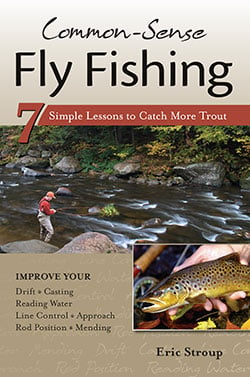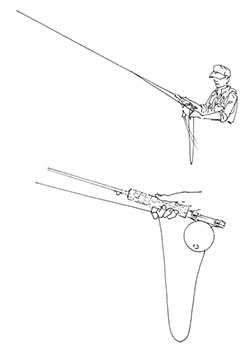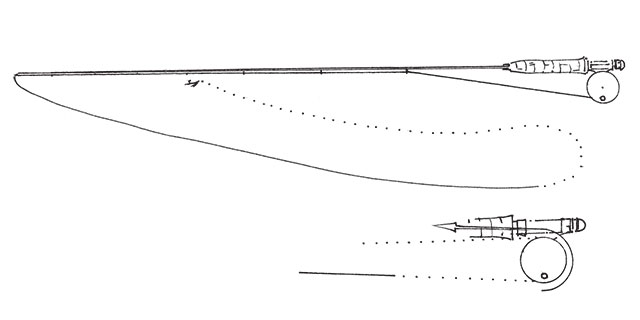Common Sense Fly Fishing: Line Control

Let’s say I have the most beautiful car on the planet, though anyone who’s ever booked a day with me knows better. Hypothetically speaking, I have a beautiful car.
This vehicle has plush leather and air conditioning, goes 0 to 60 mph in no time, handles like an absolute dream, and gets great gas mileage. There’s only one catch: It has no brakes. Would you drive it? Of course not.
The index finger on your rod hand is just as important to the fly rod as the brakes are on your car. It is in a consistent place and is the only thing near the rod that can tighten the line at any moment. It allows you to keep the perfect amount of line out of the end of the rod as is necessary, and, in conjunction with your other hand, can do the work on 90 percent of the trout you catch.
All the fly-fishing skills in the world are for naught without command of the line. Line control is the single most important, yet forgotten, discipline in the sport, and it is the most frustrating for a guide to deal with. It’s simple, but it is also the toughest to teach. Why? Because old habits die hard, and there is very little time or energy dedicated to it in our schools, literature, and practice. We place such a heavy emphasis on our presentation skills that one might think that once we raise a trout, the game is over. But, in reality, the game has just begun.
Several years ago, I was on the Kootenai River in northwest Montana with an old client, who we’ll call Tommy. (Sorry Tommy, had to use your real name on this one.) We were drifting right below the dam in an area known for big rainbows, and Tommy was in the front of the boat. Now, I’ll be sensitive as to how I’ll say this, but despite years of instruction, Tommy has never achieved any semblance of what one would call line control.

Buy the eBook in the MidCurrent Store
Tommy is a line biter. Once he sets the hook he frantically, like a great white shark, starts to search for the line with his face, choppers going full speed, looking for anything to bite onto. Once contact is made, the choppers hold onto the line until Tommy can reach for, and pull, some more line. And when he does, he uses his face to keep biting more line. Despite my best efforts over the years, I’ve never been able to correct it. Old habits die hard.
On this day, Tommy hit a beautiful 18-inch wild rainbow and went right to work. He attacked the line like a doberman, and while he had a good grip with his teeth, the ’bow jumped right at the boat, sending fly line around Tommy’s head. A knot formed around the flip-focals perched on his hat, but there was no time untangle it. The ’bow was running downstream, and all Tommy could do was grit his teeth and hang on. Tommy could not see well because of the line wrapped around his head, the back of the chair, and the back of the reel, so all our guide could do was row as fast as he could to keep up with the fish. A quarter-mile downstream, I jumped out of the boat and netted the fish that tried to strangle Tommy, and we got a picture. I never knew fishing could be so dangerous. A larger fish could have decapitated him. If that’s not reason to practice good line control, I don’t know what is.
Line control is really simple. It begins and ends with placing the fly line underneath your index finger on your rod hand. That’s it, really. While casting, the line runs through the non-casting hand. When the cast is delivered, grasp the line with the non-casting hand and transfer it under the finger of your rod hand. Strip out the excess line from behind the index finger with the non-casting hand. Continue to leave the line under the index finger of your rod hand, and strip from behind that finger.
Once the cast is delivered, the rod should not be moved unless it’s used to mend the line or set the hook. The non-casting hand should be gathering line and taking it to the rod hand. When I make a cast, I usually keep a few feet of additional fly line off the reel so I can easily reach up and grab it to begin to strip. I also use that extra line if I need to mend after the cast. Many anglers that I watch will make a great cast, and while trying to get control of the line, they start to reach with the rod hand for the line in their non-casting hand. By doing so, they’ve moved the rod so much that they’ve taken all the slack out of the leader, moved the fly, and ruined their chances for a good drift. By the time they gain control of the line, the fly has floated past the target, and they are ready to pick up to make the next cast.

One of the key ingredients to line control is getting the line under
your rod hand finger immediately after the cast. Take your line hand
to the rod hand. Don’t try to reach the line with your rod hand.
Line control is also important in casting, especially during the pickup. Anglers tend to carry too much line in the air, and regardless of how well you cast, this makes accuracy difficult. This problem usually begins with the pickup. Every angler has a distance that he can carry in the air well. I know for myself that once I surpass that distance, I look and cast like I’ve never had a rod in my hands before. There is no rule that says you have to cast the same amount of line you’re fishing. Carry less line in the air and shoot line for extra distance, if required. This may mean stripping in 10 or 12 feet before making the next cast, but you’ll generally make fewer casting mistakes if you do.
Fighting fish exposes poor line control technique quickly and mistakes have a long lasting sting, especially when large trout are lost. I see more trout lost every season when the angler is trying to get the fish on the reel. Who came up with this idea? This is not a requirement once you hook the fish. In fact, most guys who take the time to put fish on the reel still grab the line anyway while they’re fighting the fish. Don’t waste your time. A big trout will take all your line, and you’ll end up on the reel whether you want to be or not, so don’t worry about it. You can apply perfect pressure with your finger on the line, and if the fish starts to run on you, keep the pressure on the line and let it take some. The most important part of fighting a fish this way is to remember to strip line behind your finger, not in front. The index finger is the brake. Use it that way. You’ll never lose a fish because you let up on the pressure, and trust me you can strip a lot faster than you can reel.
Line Control Tips
Line control begins the minute you step in the water. If your flies aren’t in the water drifting over trout, you’re not going to catch very many. All too often, I see anglers fussing around with their
line, trying to get it out of the guides, trying to get enough line out to cast, trying to get the line unwrapped from their rod, reel, and themselves. This is wasting valuable fishing time, and it is also frustrating. Here are a few simple tips to help.

When moving on, keep the fly line out of the end of the rod, place the
fly on one of the guides, and wrap the leader around the reel. This
ensures you have enough line out of the rod tip to start fishing more
quickly. When you’re ready to fish, simply take the leader off of the reel
and tap the top of your rod. The fly will fall off the guide and you’re
ready to cast.
Double It Over
When you begin your day and you’re stringing up your fly rod, don’t try to feed the leader through the guides. Double the fly line over and feed it through the guides. This will almost ensure that you won’t miss any guides because it’s much easier to see and handle. Also, if you drop the line, it will not fall through all the guides, requiring that you start over. I know you’re thinking, “What does this have to do with line control?” Line control begins at the truck! The fly line is a tool that we use. It should be used to our advantage not our detriment. Experienced anglers and good fishermen do not spend their time fighting fly line, whether it’s at the vehicle or in the water.
Get the Line Out
Once on the stream, get the line out and make a cast. This is a time when I see a lot of anglers struggle. They dip their fly in the water and strip off 6-inch increments of line and hope that the current pulls the line out of their rod tip. As the process drags on, they shake the rod tip and the leader wraps around the tip. This is when they point the tip to me, and I strip off about 6 feet of fly line and drop the fly into the water. The next step is to pull some additional line off the reel for the first cast. They point the rod tip to the sky while they strip the line off their reel, and all of the fly line slides right back down through the guides and lands in a pile at their feet. This doesn’t have to happen.
First, when you take the fly off the hook keeper on the rod, hold the fly and pull as much line off the reel as you can reach. When you’ve reached as far as you can, and the leader is still inside the guides, drop the fly and grab the leader farther up into the butt section and pull again until you have at least a few feet of fly line out of the guides. At this point, drop everything onto the water and strip 8 to 10 feet of line off the reel. At this point, simply take the rod up to the 12 o’clock position and roll cast the line out toward the direction you’re going to fish. You can now either begin casting or continue to strip more line off the reel. Either way, the line is out of the rod and you’re not going to have any tangles.
Moving On
When you’re done fishing, point the rod toward the water’s surface as you reel in. This will prevent the line from wrapping around the rod tip, as the water surface keeps the line more stable. If you’re going to continue to fish, reel in to a point where you still have 3 or 4 feet of line out of the end of your rod tip. Take the fly and place the hook on a guide that is near the end of the rod. Next, take the leader around the reel, and gently reel in the excess line. When you’re ready to make your next cast, simply take the line off of the reel and tap the top of your rod. The fly that is hooked on the guide will instantly drop off, and you’re ready to fish or strip more line off the reel.












